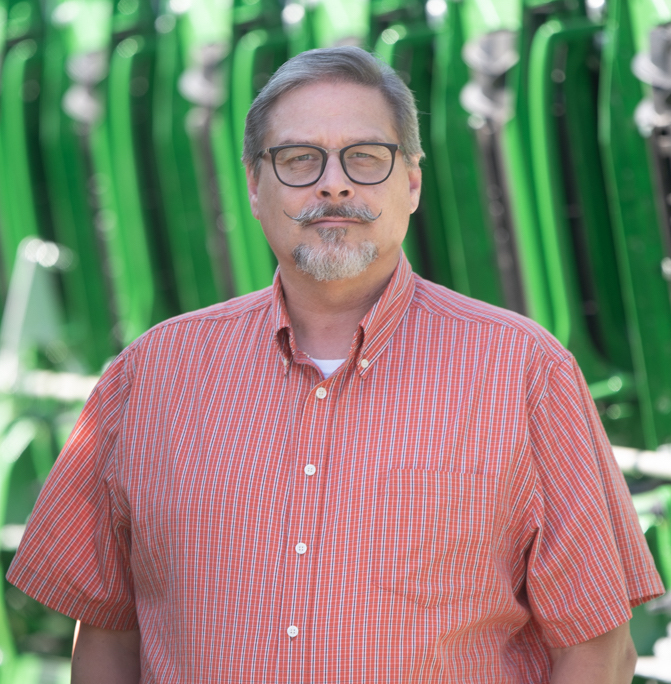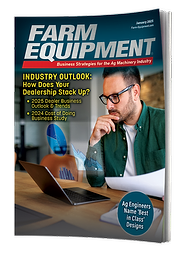While many suppliers can trace its history to a farmer building a better piece of equipment, Sean McLaughlin’s career took a different, albeit parallel, path: an ag equipment dealer who built a better piece of technology. Shortly after acquiring Craig Taylor Equipment, a 4-location John Deere dealership in Alaska, he set out to “roll his own” dealership management system (DMS) — something he was able to do thanks to his computer science education and expertise — when he couldn’t find what he was looking for in the marketplace. Today, in addition to owning the dealership, McLaughlin is CEO of DMS provider Flyntlok, based in Anchorage, Alaska.
Farm Equipment spoke with McLaughlin about his unique career path and how he sees technology evolving and serving dealerships into the future.
How did running an equipment dealership give you insight into developing your own dealer management system (DMS) solution?
At the end of the day, every software company is a service industry business. And when you’re in a dealership, you're a service industry business; a customer service business. What informed the way we went with the technology is that I made it a customer-service-forward tech company.
The most important thing I start every demo with is saying we operate on an 8-and-8 basis. We literally built customer support into the app, and we say we’re going to respond to your questions within 8 minutes and solve them within 8 hours — 8 and 8. That’s our model, and if I can’t meet it, I’ll add more people.
Out of my dealership experience, I’m reminded every day if the queue is too long, it affects the customer experience. If I don’t have things in stock, everything sucks. So I just said this is a customer service business, and that's missing from these other solutions — they’ve lost touch with their customer, and that’s why these DMS companies are the way they are. We’re going to close that gap. That’s been the biggest realization.
I noticed that when I looked at these systems, dealers seemed to believe their whole business model is somehow unique, and it’s not true. There are certain parts that are unique and others that aren’t. We took a fresh look and said, “Does this really have to be a dealer-specific piece of software or can we be part of this multi-billion dollar market and get a best-of-breed product for that part of our business? What parts are uniquely dealer-specific?” Let’s focus on those and not focus on everything. We just started breaking that down. I guess as opposed to talking about how we were different, we talked about how we were really common with other industries.
Many industry suppliers got their start as farmers building equipment to help them perform a task. You’re an equipment dealer who developed a better technology tool. Do you think this could be a trend in agriculture?
Regardless of the business, being founder-led and close to the market is critical for any developing or established platform. I still do the first demo for all of our prospective customers precisely for this reason. So yes, I believe that the manufacturers who stay close to their dealers and customers and listen to their needs will in the long-term continue to thrive.
With the future looking like more autonomous machinery, embedded electronics to identify and predict potential faults and the general understanding that most farmers and their teams are connected via a smartphone provides a great opportunity for manufacturers who are agile and close to the market.
To your other point, we are now signing customers where the next generation is coming into the dealership. A lot of them are family businesses, and the kids are coming out of college and has grown up with an iPhone in their hands the whole time. They show up and say, “I have to switch the system out. I have to get this thing automated. I need to connect it to everything else I’m doing.” And these kids are writing software.
In the world now, there are these low-code environments. These kids have built systems now on top of all the old stuff. It’s fun to see. They’re able to do things that couldn’t be done before. They’re solving problems, and they’re not necessarily computer scientists, but they just know how to take tech and apply it to a problem.
What business technology trends do you think equipment dealers need to be aware of in the coming 1-3 years?
Improving the connectivity between the dealer and the fleet and customer is critical. This is the biggest gap because all of the legacy DMS systems were built in a period basically before connectivity. They have a big problem trying to integrate all that. It’s all about connectivity.
I’ve spoken to many customers who don’t have an easy way to identify the status of their assets once they are transported from the dealership and are struggling with too many OEM portals. Also, many of these medium-size fleets don’t have large staff and dedicated asset managers. The easier it is to create a service request regardless of brand — the dealers that are providing that capability will excel.
Finally, I strongly believe that as the market shifts toward more EV and smarter equipment, we need to make the life of a technician simpler and the platforms that support the diagnostic and repair process simpler.
As technology changes and customers’ expectations change, what will be the biggest change in dealerships in the next decade?
It’s making a dealership feel like more of a space where people have done most of their homework before they show up, and the “show up” part is really not all that important. They’re looking for channels where they don’t have to actually interact directly on these things.
I say your dealership is running well when the phone rings less, which seems counterintuitive because I’m talking about connectivity and communication. But it’s because the whole world is moving to a point where no one wants to talk on the phone — no one wants to communicate that way. No one wants to sit on hold with dealerships. Probably the most inefficient thing that happens is the phone ringing in a dealership.
We are seeing more customers completing transactions through smartphones, and the opportunity to respond quickly to a customer looking for a product or service is critical. Our DMS is really driven to that. It’s hyperfocused on SMS messaging and emailing, doing things remotely and getting signatures remotely and letting people respond remotely.
Then I'm in these dealerships where they have these intercoms. It's like, “Bob, line 1, please.” You hear this stuff barking through the whole place. I took all those out of my dealerships — I literally took all those speakers out. I’ve been in other dealerships and heard it barking in the background, and that’s the thing we have to get rid of right there. The world is already there. The dealers have to come into it and just get to that level of sophistication.
From Software to Selling Equipment and Back Again
The route Sean McLaughlin’s career has taken — one which currently sees him as owner of Alaska John Deere dealership Craig Taylor Equipment as well as founder and CEO of DMS provider Flyntlok — is one that could truly be called “full circle.”
“I was a computer science graduate out of college, and then I was Air Force ROTC,” he says. “Then President Clinton did a drawdown of the Air Force, and I was let free. I had no career, and I was getting married at the same time, and literally at the time people were starting to put networks in and stuff.”
McLaughlin’s first customer was a financial industries hedge fund, but that client ended up hiring him as a full-time employee almost immediately. “I turned that into building a very big software company for hedge funds for financial industries that traded stocks and bonds,” he says.
After 11 years, his restless nature got the better of him, and he was recruited into the White House Fellows program.
“They pick 12 people a year, and you go work in the executive branch of the government and perform a function similar to what you were doing in the private sector. In my case, I worked on treasury computer systems,” McLaughlin says. He resigned, though, after realizing he didn’t have the temperament for working in government. He did, however, have “this crazy dream to move to Alaska,” which McLaughlin and his family did in 2005.
Once there, he was in his local Bobcat dealer one day in 2014 when he learned the dealership — Craig Taylor Equipment — was for sale. The original owner had died, his widow was in her 90s and McLaughlin’s wife wanted him out of the house. “When you’re a computer science person, you’re dealing with nothing tangible,” he says. “You're writing code in your head. Everything’s ephemeral. I thought it would be fun to work with something that I could actually look at and touch. It struck me as a good thing to do.”
It wasn’t long before McLaughlin realized how “old school” his dealership’s processes were. “Everything was paper — there were piles of paper everywhere,” he says. “I'm just looking at it going, this is insane.” His first order of business was getting email addresses for his entire staff. Then he hired a young man who understood technology to get the company onto a DMS.
In demo after demo, McLaughlin found himself underwhelmed by what he was seeing. “No one expected a computer science guy to be sitting at a dealership,” he says, adding that he couldn’t help but see the shortcomings in the DMS code.
“I'd be in these demos, and I’d have this experience about how bad the technology was, and the cost was extravagant,” he says. “I was used to high-cost software because I came from the financial industry, but a dealer's business model does not have a lot of money for technology — it’s just a tight-margin business. So I just got to this point where I was really frustrated, and my guys turned to me one day in a meeting and just said, ‘Well, why don't you just write it?’ They said it almost like a threat because I wasn’t willing to pull the trigger on any of the products that were out there. And I'm like, ‘You know what? I'm going to do that.’”
McLaughlin’s oldest daughter is a computer scientist, although at the time she was still in high school. He hired her and one of her friends to help him write the software that became the basis for Flyntlok. Current dealers using Flyntlok include Grassroots Equipment, Thomas Outdoor Supply, LKN Small Engine and Hobby Tractors.
And the young man McLaughlin had tasked with getting Craig Taylor Equipment on a DMS platform? His name is Chris Devine, and he’s still working for McLaughlin, albeit with a few more responsibilities.
“He’s now the CEO of my dealership,” McLaughlin says. “When we bought the dealership, it was doing $19 million in sales. Now we’re doing $80 million.”






